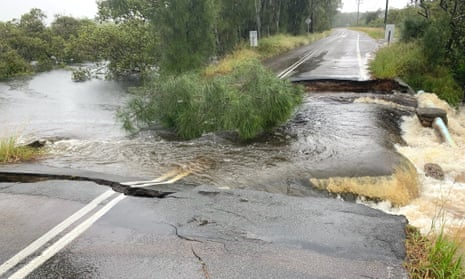Evacuation orders were issued for a number of towns on New South Wales’ waterlogged mid-north coast as a “potentially life-threatening” deluge continued.
Sydney residents were warned to brace for similar weather on Saturday, with flash flooding and also flooding of the Nepean and Hawkesbury rivers forecast.
Residents in low-lying areas of Port Macquarie were told to evacuate on Friday afternoon with authorities saying a “significant” number of properties could be flooded. People in nearby North Haven, Dunbogan, Diamond Head and Laurieton were also ordered to evacuate with flood waters likely to impact utilities including water, power and internet services.
Those of you familiar with Port Macquarie know this is the road to the airport. Safe to say no-one is flying out of Port Macquarie tonight. #NSWFloods pic.twitter.com/F9mZa1kZ2T
— Paul Jobber (@paul_jobber23) March 19, 2021
Flood warnings were current across many of the major rivers on the mid-north coast – as well as greater Sydney and the state’s far west.
Video online showed a kangaroo being swept along in flood waters at Kempsey, on the mid-north coast, before managing to climb out onto the bank.
Lucky escape! 🦘
— 9News Sydney (@9NewsSyd) March 19, 2021
A kangaroo has managed to swim to safety after getting trapped in floodwaters at Kempsey, on the NSW Mid-North Coast.
Flood alerts are in place across the state: https://t.co/Z6uF1fkS96
Latest details on #NSWFloods tonight at 6.00pm on #9News pic.twitter.com/iQXr3VZq4h
“We are seeing very intense, very heavy, potentially life-threatening rainfall happening on the mid-north coast right now,” the Bureau of Meteorology’s Agata Imielska told reporters on Friday.
“We’re seeing rainfall totals of over 100mm falling in about an hour. That is very dangerous rainfall.”
The bureau’s flood manager, Justin Robinson, said there had been significant river level rises in Bowraville and Bellingen, with major flooding also expected along the Gloucester River and some flooding forecast for Taree.
Fourteen people had been rescued from flood waters and the State Emergency Service received 400 calls for help on Thursday night and Friday.
Robinson warned there would likely be a spill from Warragamba Dam, Sydney’s largest water reservoir, on Saturday, which could impact downstream communities.
The NSW premier, Gladys Berejiklian, urged people not to travel around flood- and storm-affected areas.
“Normally we’re telling people to travel around NSW, but this weekend is an exception,” she told reporters. “We just want everybody to stay around and close to their homes, to be safe and to follow those messages. This weekend is going to be quite severe.”
Earlier, the BoM warned that heavy rainfall forecast for Friday and Saturday could cause falls of up to 600mm in some parts of the mid-north coast.
A flood evacuation warning has been issued by @NSWSES for low lying areas of Bulahdelah. pic.twitter.com/dW1DRmHf7T
— Alison Paul (@AlisonPaulCoffs) March 18, 2021
It comes after up to 100mm of rain fell across the regions overnight on Thursday, leading to hundreds of calls for help.
Flood watch alerts were issued for the mid-north coast, the Hunter, the Central Coast, Sydney metro and the Illawarra coast, and the far west.
On Friday, the BoM issued a raft of flood warnings, as well as severe rainfall warnings. The bureau said that the state’s mid-north coast between Forster and Coffs Harbour could expect to see intense rainfall over the next six to 12 hours before the weather system shifted to the Hunter region.
#wayway #flooding #7newsaustralia #midnorthcoast #nsw pic.twitter.com/SpTK0CqMmV
— Milky (@_HeYGoogle) March 18, 2021
“In these areas, there may be periods of intense rainfall, potentially leading to life-threatening flash flooding,” the bureau said.
“Roads are likely to be cut off by water, and there will be an increased risk of landslips over this period.”
This article includes content provided by Instagram. We ask for your permission before anything is loaded, as they may be using cookies and other technologies. To view this content, click 'Allow and continue'.
Emergency services warned that conditions would remain dangerous and were telling motorists to take “extreme care” around flood warning areas.
The deluge was set to continue well into next week and could deliver the heaviest rainfall since February 2020.
Catchments were already soaked but it won’t take much more for flooding to occur, Imielska said.
“It’s the difference between being inconveniently wet to conditions drastically changing to being dangerously wet,” the meteorologist said.
The bureau said the low-pressure system was a “significant system” bringing peak gusts of more than 90km/h.
First casualty of the big Sydney rain. This railway station subway in Lewisham in the inner west. Commuters having to hurdle over handrails to avoid the muddy puddle. @T2SydneyTrains pic.twitter.com/6xnSSlZgj2
— Benedict Brook (@BenedictBrook) March 18, 2021
Forecasters said more than 100mm of rain was expected to fall in a short period of time in some regions.
“We’re very concerned about the potential for flooding along the coastal rivers from the mid-north coast down to Sydney,” Robinson said.
Red sky in the morning - sailor's warning.
— Marine Rescue NSW (@MarineRescueNSW) March 18, 2021
This photo this morning from Cronulla warns of severe weather ahead.
Marine Rescue's message is clear - in areas affected by the Flood Watch - stay safe and stay off the water this weekend. pic.twitter.com/DxtCKjFowr
The SES chief superintendent, Greg Swindells, said drivers should reconsider their travel and must not drive through flood waters.
“The people that enter those flood waters in their vehicles are people that are local to the area and think that ‘I know the road better and I’ll be OK’,” he said.
“That’s not the case ... it doesn’t matter how experienced you are as a driver or how big your vehicle may be.”
Inland NSW was also expected to get its share of the rain when a separate system moved in next week.
